Intel Core Duo: AOpen i975Xa-YDG to the Rescue
by Gary Key on May 4, 2006 8:00 AM EST- Posted in
- Motherboards
Audio Performance
We limited audio testing to the Rightmark 3D Sound version 2.2 CPU utilization test and tested with sound enabled to show the performance effects on several games. The Rightmark 3D Sound benchmark measures the overhead or CPU utilization required by a codec or hardware audio chip.
The Realtek ALC-880 HD audio codec on the AOpen board was tested with the recently released 1.36 driver set. The Realtek DirectSound audio drivers do not support more than 32 hardware buffers and the OpenAL 1.1 drivers do not support more than 30 hardware buffers at this time so the scores cannot be directly compared to the Creative Labs Sound Blaster X-Fi cards in the benchmarks.
It is interesting to note the reduced CPU utilization with the Core Duo or Opteron 165 as the load is balanced between each processor with the Realtek 1.36 drivers and the Creative drivers to a certain extent. However, these CPU utilization rate improvements with the dual-core setup does not have any bearing on actual game benchmarks as the reduction in frame rate percentages are the same as our single core score.
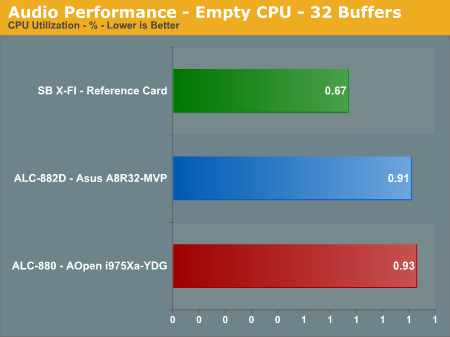
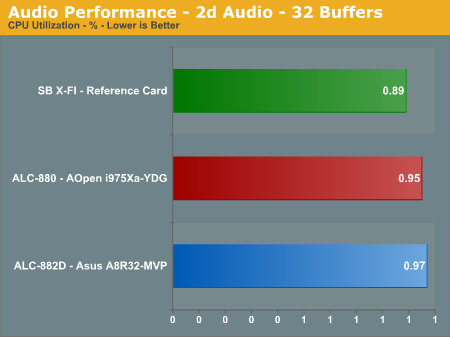
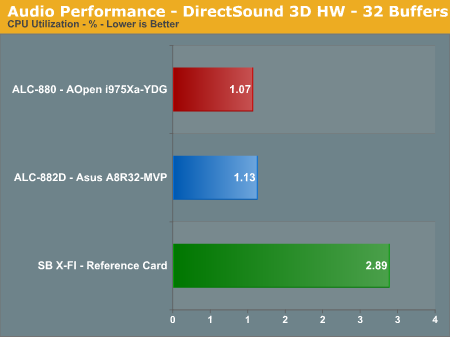
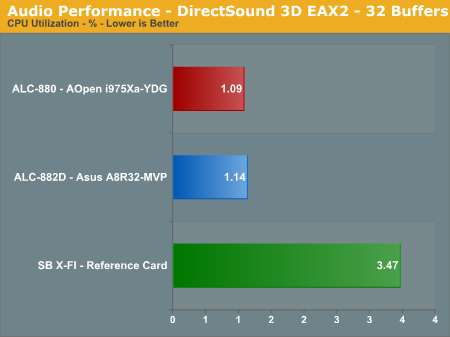
The Realtek ALC-880 codec offers very competitive CPU utilization rates when compared to the Realtek ALC-882 on the Asus board. The ALC-880 generates significantly better audio quality than the AC97 based systems and very similar audio quality to the ALC-882 solution. The ALC-880 was released before the ALC-882 but has nearly the same audio quality and performance in our testing. Our subjective headphone testing revealed a slight difference between the two codecs, with the output from the ALC-882 sounding clearer in the treble and mid-range tones. However, the difference was negligible when utilizing our 4, 5.1, or 7.1 speaker setup in a typical room environment. The Sound Blaster X-Fi has the lowest overall CPU utilization (single core systems) with the ALC-880 and the ALC-882 following closely. Let's find out how these results translate into real world numbers.
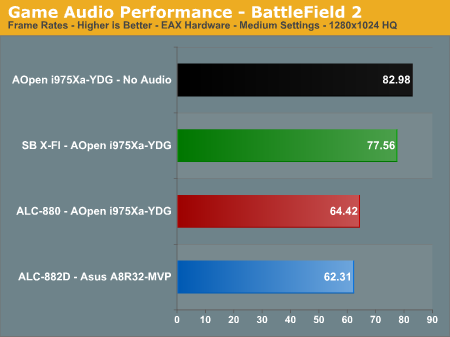
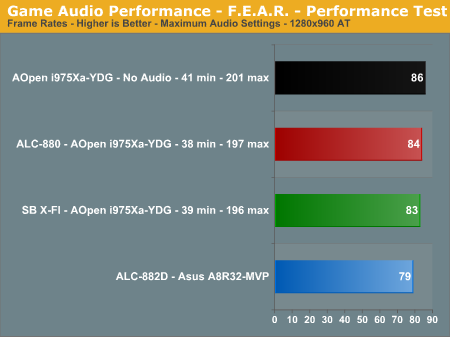
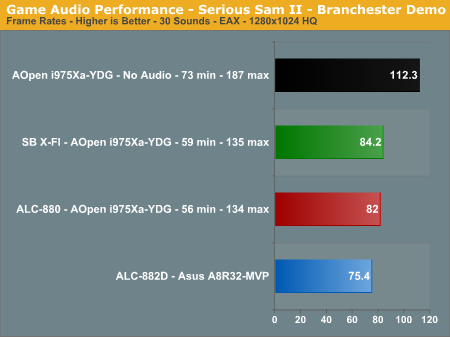
The audio performance numbers remain consistent as the Realtek ALC-880 consistently finishes near the SoundBlaster X-Fi in the benchmarks. Serious Sam II has an average loss of 37%, Battlefield 2 at 28%, and F.E.A.R. at 2%. F.E.A.R. is extremely GPU limited so the CPU has additional cycles to generate the audio streams required by the Realtek drivers.
The overall output quality of audio with the Realtek ALC-880 ranks with the ALC-882/883 series as the best of the on-board HD audio solutions we have heard to date, while performance continues to improve with each driver release. The vast majority of users should have no issues utilizing the ALC-880 as their primary audio solution considering the quality of audio and performance at this time in most applications.
Obviously, if you are a serious gamer, then a dedicated sound card is still useful to ensure consistent frame rate averages across a wide variety of games, and in the case of the Sound Blaster X-Fi, you also get improved audio quality and EAX3/4/5 support. If you'd like more details on the Realtek solution, you can refer to the Realtek ALC-880 Specifications.










81 Comments
View All Comments
Viditor - Thursday, May 4, 2006 - link
Premiere Pro 2.0 has a 64 bit version that works very well. It has not yet been "optimized" for 64 bit (meaning that basic functions won't run much faster), but you have access to 4 GB+ of memory (which can be a HUGE help when dealing with very large movie and audio files).http://www.adobe.com/products/premiere/pdfs/premie...">Adobe Premiere Pro 2.0 pdf
Griswold - Thursday, May 4, 2006 - link
This was obviously a test of a mobile CPU on a desktop platform, so his point is valid. And what does SFF have to do with it?Calin - Thursday, May 4, 2006 - link
That more than 50% overclock is mind boggling - I hope this will bode well for the soon-to-be released Intel processors. Performance as good as or better than Opteron 175? Looks like Intel already have this side of the market covered.xsilver - Thursday, May 4, 2006 - link
have intel chipset limitations been discussed on the upcoming conroe?wont all conroes be runnning 1066fsb already? meaning there is little headroom left for fsb overclocking unless some serious progress is made on the new chipsets?
(300ish fsb is the current general limit for intel chipsets right?)
Gary Key - Thursday, May 4, 2006 - link
We felt guilty when raising the voltage up to 1.3875 as temps increased from 25c to 31c, makes you wonder what a really good heatsink/fan will on this board. :) Anyway, I think we reached the limit of our board around 267fsb in further testing with a water cooling unit. I am sure the CPU had more in it as temps were around 26c at load, or maybe not. We spoke with AOpen and it appears the boards will top out around 275FSB at this time, we had an early board and based upon some user experiences the retail boards are doing around 275 at this time. We have a retail board on the way for our HTPC article.
Griswold - Thursday, May 4, 2006 - link
What was the ambient (room) temperature?Gary Key - Thursday, May 4, 2006 - link
It varies during the day, variation is 20c~22c. There is a new program out that will measure the Yonah core temperature through the on-chip diode instead of the AOpen thermal sensor. I withheld our temperature and power consumption numbers until we decide which temperature reading to report as another utility in XP gives a slightly different reading also. Power consumption is excellent.
Our test system (11x255, ~2.8GHz)-
X1900XT
idle - 114w
load - 232w
X1900 CrossFire (P4 of video cards)
idle - 139w
load - 357w
redbone75 - Thursday, May 4, 2006 - link
That price is a bit daunting for a mobo. This is where if you absolutely have to build a PC right now I would go with an AMD system b/c you still get stellar performance at a lower price point. The A8R32-MVP is a little under $200, and the Opty 165 still costs less than the Core Duo T2400. So, although this is a great effort from Aopen, I personally would build the AMD system or just wait for Conroe/Merom to launch. Boy, but does this make your mouth water if you choose the latter, doesn't it?dexvx - Sunday, May 7, 2006 - link
Lol, what happened to the fanboi arguement of saving power for the long term (if you visit the AT forms, its frequently used arguement for not buying a cheap Pentium-D system)? Based on the powerdraw tests from Tech-report.com, you save more power going from a X2 to Yonah than from Pentium-D to X2.That Aside, this Aopen board *is* Meron compatible with a bios update. The folks over at xtremesystems.org has confirmed it.
Schmeh - Thursday, May 4, 2006 - link
I absolutely agree. I have been putting of upgrading my system for almost a year and I am glad that I did. I can't wait to see what Conroe and Merom have to offer. My only fear is that Intel will overprice them at launch.